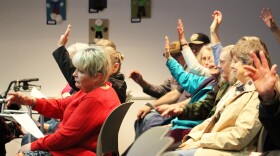The Kenai is getting a crash course in local economics, thanks to an effort from the school district’s Board of Education to help the public better understand school district budgeting.
KPBSD’s Budget 101 series arose after public protest during last year’s budget process, when the district considered cuts to services like pools and theaters while facing a deficit.
The series kicked off in September with a lesson on the state funding formula. The district’s finance director, Liz Hayes, hosted the conversation.
Hayes explained 70% of the district’s general fund money comes from the State of Alaska. Funding is calculated through a formula fueled by the number of total students, which is counted over a 20-day period in October. Then the formula makes adjustments, based on factors like the sizes of schools, and something called the “district cost factor” which accounts for varying education costs across the state, with Anchorage as a baseline.
“Several years ago, they did a study in the state of Alaska and found out that — well, I think everybody knew this, but they acknowledged it at the state level — that it costs different amounts of money to educate students in different regions of Alaska,” Hayes said.
That’s followed by a special education factor, then a vocational education factor. Then there’s additional money for intensive needs students, followed by an adjustment for homeschool students, which slightly decreases the district’s funding. That final number is multiplied by the Base Student Allocation, or BSA, the amount of money the state allocates per student.
“So you're going to times that and you're going to come up with $102,661,775,” Hayes explained. “That's what the state considers the basic need for this district.”
But that number, she said, isn’t exactly what KPBSD will get from the state. A percentage of that money must come from the borough, and that portion is based on assessed property tax value. The borough can choose how much to fund within a range, with a maximum amount, which it elected to provide this fiscal year.
Hayes warned that barring changes in the BSA or funding from the state legislature, the district will come up short of what it needs next year.
“So right off the bat, right out of the gate, starting for FY25 school year, we will be facing a minimum of a $13 million deficit,” she said.
Board members discussed that process, and talked about keeping cuts away from the classroom as much as possible. East Peninsula Board Member Virginia Morgan asked the public to be understanding of the pressures on the district.
“So I hope the public understands this, and understands that this is no scare tactics, that the board is trying to cut the popular programs to get people out. This is just the reality, because of the timeline and what the current decisions are of our legislature,” Morgan said. “And so we're going to be looking at some really scary cuts very soon.”
This week, Hayes presented about in-kind services with the help of Borough Finance Director Brandi Harbaugh. Harbaugh explained that these services, which the borough pays for on behalf of the district, include maintenance, insurance, an annual audit, custodial services and utilities. That money comes out of the same pot as the borough’s general contribution to the district.
Harbaugh walked the board through the process. She said that of the borough’s current $54.7 million contribution to the district, approximately 40 million is provided to the school district directly in cash.
“So we cut it up into 12 pieces and we cut the school district a check — well, we don’t cut it a check, but we put it in the ledger — once a month. So that cash is then accepted in to pay wages, and programs and utilities and things like that at the school district,” she explained. “And beyond that, these other five components are also a portion of these 54.7. We’re really only cutting a check to the school district for the 40 million and the rest of it we’re paying on behalf of.”
There are two more Budget 101 events: in November, the district will tackle the fund balance and the District Savings Account, then the series will wrap up in December with a discussion of the chart of accounts, or how the district tracks and reports its spending. You can learn more about the series here.







